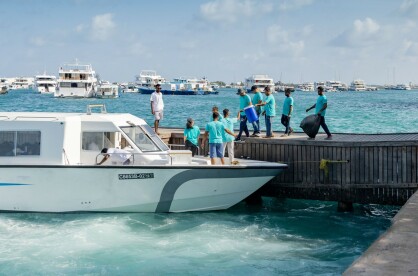Switching to solar
The future for solar energy in the Maldives is looking bright, both metaphorically and realistically.

Source - Swimsol
The future for solar energy in the Maldives is looking bright, both metaphorically and realistically.

Source - Swimsol
Renewable energy is the obvious answer, barring the lack of justification for a nuclear power plant in the humble, disjointed nation of the Maldives. Since 2009, the demand by the public for greater sustainability in infrastructure development has not been met with the gusto that was expected, yet there are certain advancements that do warrant mention today.
Being the sunny side of life is self-explanatory; the abundance of year-round sunshine is a natural resource that the Maldives could have been entirely dependent on already. Given how the nation spends upwards of 10 percent of GDP on importing fossil fuels, the cost power from solar compared to the higher cost power equivalent in the most efficient diesel plant are all incentives to switch over to renewable resources as soon as possible.
This will alleviate a major stress point on expenditure, and on top of that, will also garner international attention by being a nation thriving on naturally sustainable resources. The announcements in 2009 and onwards regarding going carbon-neutral and the like had raised a lot of attention worldwide, but the lack of fruition to those statements have created a lacuna in the global expectations of Maldives.
There have been multiple projects so far, and one them worth mentioning first is Gasfinolhu Island Resort. A 2-year project that racked a USD6 million bill, this was the first resort in the Maldives to be fully powered by renewable energy, with solar panels on the roof above the jetty, along pathways, as well as floating photovoltaic systems in the lagoon. The investment was a hefty one, but given the surging trends of the more eco-aware travellers, this is the next step in boosting the Maldivian hospitality portfolio.
To achieve this step, Preparing Outer islands for Sustainable Energy Development (POISED) was implemented in 2014 with the support of the Asian Development Bank. This project carried the expectations of providing benefit for over 160 islands around the nation. The trial structures were built and tested in the same year, as a floating solar system, and showed that the system worked 10 percent better when placed on water as compared to being placed on rooftops, given the cooling effect of the ocean. They were recorded achieving over 28 percent in fuel savings when used in a hybrid system alongside diesel, as compared to a system using only fossil fuels.
Moving forth, even the World Bank stepped up with the Accelerating Renewable Energy Integration and Sustainable Energy (ARISE) program, aiming to install solar panels capable of generating 11-14 megwatts in 14 islands. The project cost was over USD107 million, which included a USD12.4 million grant from the International Development Association (IDA). Financing from non-World Bank Group entities includes USD30 million from the Clean Technology Fund, USD20 million from the Asian Infrastructure Investment Bank (AIIB), and USD45 million in commercial financing.
This project aims to develop and ensure post Covid-19 measures by focusing on combining the risk mitigation mechanisms with innovative solar technologies, storage solutions and grid upgrades. This would allow existing electricity grids to be upgraded to accommodate an increasing volume of renewable energy, while battery systems will be developed in the southernmost Addu City and other islands to ensure the integration of variable renewable energy and a reliable supply in a cost-efficient manner.
In addition, under the project’s technical assistance package, targeted actions will be taken to increase women’s participation in the Maldivian energy sector. This includes creating more jobs and opportunities for women in this sector, including outreach programs dedicated to female students and providing skill development courses for women in the outer islands.
On 22 December 2021, the Maldivian Government and the Asian Development Bank (ADB) signed a transaction advisory services (TAS) agreement for the development, structuring and international tendering of a solar photovoltaic (PV) PPP project in 20 to 25 outer islands of the country with a combined capacity of 20 to 30 MW. The project installations will be a combination of land, rooftops and nearshore lagoons with 1-2 MW of solar PV in each of the identified outer islands of the country. The integration of floating PV requires feasibility studies to establish the locations and technologies to be used, considering that lagoons are scarce in the Greater Male’ Region.
A bit closer to the capital, the installation of PV panels in the Greater Malé Region has increased in the past 5 years, reaching more than 3000 kWp at the beginning of 2020. Hulhumalé sums 1.5 MW of rooftop solar PV operating since March 2018 under a power purchase agreement (PPA) at a fixed price of USD0.21/kWh for 20 years. The infrastructure is supported under the Accelerating Sustainable Private Investments in Renewable Energy (ASPIRE) project, which is also funded by the World Bank. The intention with this is to achieve at least 10 percent energy efficiency by 2030.
While these are sources of investment that are backed by other nations, private investment into this field of energy generation has not been lacking either. In 2020, an interview with the then-Minister of Environment Husain Rasheed Hassan, revealed that a total of 58 solar investing applications were received for pre-qualification. Out of this, 24 were received for floating PV and 34 for ground-mounted PV.
One such investor was Avi Technologies, with 15 major projects between 2016 to 2019, installing solar panels in islands spread across more than 10 atolls. Buildings with rooftop solar panels included multiple Bank of Maldives (BML) branches, schools, colleges, guest houses, and more. Notable projects include Ghafoor Cable Net, one of the leading Cable TV services provider in Dh. Kudahuwadhoo. Almost all the electrical equipment necessary for their services are powered by solar energy. By 2018, Avi Technologies had installed approximately 2.268MW Solar Panels, 3.2MW Diesel Generators, 3.78MWH Energy Storage Systems across 14 islands of Haa Alif atoll. This project has significantly reduced the energy production cost in the region by harvesting solar energy and reducing dependency on diesel.
The leading solar energy company invested in the Maldives is Swimsol, having implemented not only land panels, but floating solar systems branded SolarSea(R) across the country after years of trial and testing. Swimsol has successfully implemented more than 13 projects for both land and floating solar systems since 2014 till 2021.
The future for solar energy in the Maldives is looking bright, both metaphorically and realistically. The major obstacles now include the requirement to still hook up one’s self-sustainable system into the main power grid and continue paying the same bills as a diesel-powered home, and also the monopoly on fossil fuels economy that has a tight grip on the energy industry, especially in the Greater Malé Region.
While switching entirely to renewable resources will not cause even the slightest dent in the climate crisis given the very tiny size of the country, leading by example and dedication would most certainly render more weight to the country's arguments on the international stage. The Maldivian administrations should be involved in more sustainable development plans before trying to pull a 5-year attempt at outshining the leaders that came before them, as the climate crisis is now considered a child right’s issue by the UN as well.
There has been talk of changes to the current, outdated policies, and the year ahead is ripe for such changes to come to fruition. Not only can the nation sustain its half a million inhabitants on renewable resources, but it would generate the necessary level of attention to have a significant effect on the hospitality industry in the long run as well.



